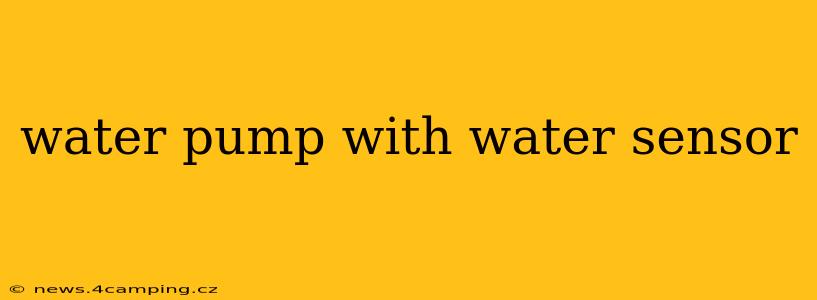Efficient and automated watering systems are crucial for maintaining healthy plants, conserving water, and saving time. A water pump with a water sensor provides the perfect solution, ensuring your plants receive the precise amount of water they need, when they need it. This comprehensive guide explores the benefits, different types, installation process, and troubleshooting tips for water pumps with integrated water sensors.
What is a Water Pump with a Water Sensor?
A water pump with a water sensor is a self-contained system designed to automate the watering process. The system includes a water pump, a sensor that monitors soil moisture levels or water tank levels, and a control unit that manages the pump's operation based on the sensor's readings. When the sensor detects low water levels or dry soil, the pump automatically activates to deliver water until the desired level is reached. This eliminates the need for manual monitoring and intervention, ensuring consistent hydration for your plants.
Different Types of Water Pumps with Water Sensors
Several types of water pumps are available, each suited to different applications and needs:
-
Submersible Pumps with Level Sensors: These pumps are submerged directly into the water source (e.g., well, tank). A float switch or pressure sensor monitors the water level, triggering the pump when the level drops below a certain point. This is ideal for large-scale irrigation or water features.
-
Surface Pumps with Soil Moisture Sensors: These pumps are positioned above ground, drawing water from a source and delivering it to plants through a drip irrigation system. Soil moisture sensors embedded in the soil monitor moisture levels, instructing the pump to activate only when necessary. This is a popular choice for gardening and home landscaping.
-
Smart Pumps with Wireless Connectivity: These advanced systems often incorporate Wi-Fi or Bluetooth connectivity, allowing remote monitoring and control via a smartphone app. They offer features such as scheduling, customized watering patterns, and real-time data on water usage.
How Does a Water Pump with a Water Sensor Work?
The operation is straightforward:
- Sensor Monitoring: The sensor continuously monitors the water level or soil moisture.
- Threshold Detection: When the sensor detects that the water level or soil moisture has fallen below a pre-set threshold, it sends a signal to the control unit.
- Pump Activation: The control unit activates the water pump.
- Water Delivery: The pump delivers water to the plants or water reservoir until the desired level is reached.
- Pump Deactivation: Once the desired level is reached, the sensor signals the control unit to turn off the pump, conserving water and energy.
How to Install a Water Pump with a Water Sensor
The installation process varies depending on the type of pump and sensor, but generally involves these steps:
- Planning: Determine your water source, irrigation system, and the placement of the sensor(s).
- Wiring: Carefully connect the pump, sensor, and control unit according to the manufacturer's instructions.
- Sensor Placement: Position the sensor in the soil or water source to accurately monitor levels.
- Testing: Thoroughly test the system to ensure it functions correctly and adjusts the settings as needed.
Choosing the Right Water Pump and Sensor for Your Needs
Consider these factors when choosing a water pump and sensor:
- Water source: Determine if you have a well, tank, or other water source.
- Irrigation system: Consider the size of your garden or landscape and the type of irrigation system you'll be using (e.g., drip irrigation, sprinkler system).
- Water pressure: Ensure the pump can deliver sufficient water pressure to your plants.
- Power requirements: Check the pump's voltage and amperage to ensure it's compatible with your power supply.
- Budget: Prices vary widely based on features, capacity, and brand.
Troubleshooting Common Problems
- Pump not turning on: Check the power supply, wiring connections, and the sensor's functionality.
- Pump running continuously: The sensor might be malfunctioning or the threshold setting might be incorrect.
- Inconsistent watering: Adjust the sensor's sensitivity or check for leaks in the irrigation system.
What are the benefits of using a water pump with a water sensor?
Using a water pump with a water sensor offers several key advantages, including:
- Water Conservation: By only delivering water when needed, the system prevents overwatering and conserves precious resources.
- Improved Plant Health: Consistent hydration promotes healthier plant growth and reduces stress.
- Time Savings: Automation eliminates the need for manual watering, freeing up your time for other tasks.
- Convenience: You can remotely monitor and control the system, even when you're away from home (for smart pumps).
What type of sensor is best for a water pump?
The best type of sensor depends on your specific application. Soil moisture sensors are ideal for gardening and landscaping, monitoring the soil's moisture content directly. Level sensors (float switches or pressure sensors) are better suited for monitoring water levels in tanks or reservoirs.
How often should I check my water pump with a water sensor?
While the system automates watering, regular checks are still recommended. Periodically inspect the sensor for proper functionality, check for leaks in the irrigation system, and ensure the pump is operating efficiently. The frequency of checks depends on the system's complexity and your comfort level.
How can I maintain my water pump with a water sensor?
Regular maintenance prolongs the life of your system. This includes cleaning the sensor regularly to ensure accurate readings, inspecting the pump for wear and tear, and checking for any leaks or blockages in the pipes or tubing. Following the manufacturer's maintenance guidelines is essential.
By utilizing a water pump with a water sensor, you can transform your watering routine from a tedious chore into an efficient and automated process. This not only saves you time and water, but also promotes healthier plant growth and a more sustainable approach to gardening and landscaping.
